|
Blue Damselfish
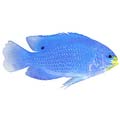
Call For The Best Price In Town!
The Blue Devil Damselfish, also known as the Blue Damselfish, is the Molly of saltwater aquariums.
It is a very colorful, hardy, and active fish. The female is all blue; the male has an orange tail, and is known by the common
name of Orangetail Blue Damselfish. In the wild, Blue Devil Damselfish are found throughout reefs, usually busy defending
a small territory. The Blue Devil Damselfish has the ability to hide in a hole or crevice and darken to an almost black color.
This usually happens when it is threatened. After the perceived threat is gone, it will turn electric blue in a matter of
seconds.
The Blue Devil Damselfish is somewhat aggressive, so its housing should be able to easily accommodate multiple specimens.
It is a good fish for beginners, and makes an ideal companion fish for a saltwater tank of over 30 gallons, and as a great
companion for reefs and invertebrates. As the fish matures it may become aggressive, causing problems with the selection of
other species to be added to the aquarium. If keeping with other damselfish, provide multiple hiding places to break up territories
and decrease aggression.
The Blue Devil Damselfish diet should consist of flaked and frozen foods, and herbivore preparations.
The Blue Devil Damselfish is probably the best selling marine fish in the United States. Its hardiness and small size make
it the most common fish used for cycling a saltwater tank.
Approximate Purchase Size: 3/4" to 1-1/2"
Harlequin Tusk (Australia)
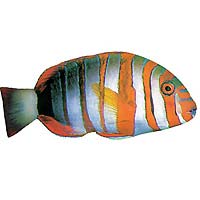
Call For The Best Price In Town!
They come in three sizes Small, Medium, and Large.
Harlequin Tusk (Wrasse), Choerodon fasciatus , is a native of the Australian waters surrounding the world famous
Great Barrier Reef. This carnivore adapts to aquarium life when offered a wide variety of meaty foods such as brine shrimp.
It can reach a mature size of approximately 10 inches and is generally not recommended for a reef aquarium. Fish from Australia
display brighter more vivid coloration than their counterparts from other parts of the world. A sand bed and live rock should
be provided for all wrasses. They will bury themselves in the sand to sleep or hide. Live rock provides numerous small life
forms that the wrasses consider a tasty treat as well as another place to hide when they feel threatened.
Powder Blue Tang
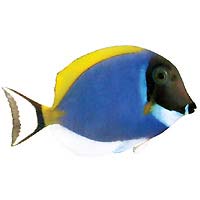
Call For The Best Price In Town!
Powder Blue Tangs, Acanthurus leucosternon, are found dispersed throughout the waters of the Indo Pacific region.
Members of the genus Acanthurus are also called Surgeonfish, making reference to the scalpel-like spines located at the base
of the tail. These Tangs are agile swimmers and entertain the aquarium viewers with their amusing antics. Tangs are herbivores
and their diets should therefore contain a variety of marine vegetable matter, such as seaweed. Be sure to provide passages
within the rockwork of the aquarium to provide security for the Tangs. It is not unusual for the coloration to look faded
or blotchy in the mornings. The normal coloration will return within a few hours. As with any members of the Tang family,
use of a quarantine aquarium for initial introduction is recommended.
Purple Tang

Call For The Best Price In Town!
The highly sought after Red Sea Purple Tang, Zebrasoma xanthurum has more recently been made available to Noah's
Ark from locations in the Red Sea. Some specimens can be aggressive and should be added at the same time as other Tangs or
should be smaller than other existing Tangs. It can grow to 6 inches in captivity and about twice that in the wild. To maintain
its deep folors and prevent Head and Lateral Line Erosion be sure to feed it vegetable-based prepared diets and fresh zucchini,
broccoli and spirulina. Vitamin supplements such as Selcon are also recommended. It is considered a "reef safe" fish and may
even eat filamentous algae. Like all Tangs, it should be quarantined before being added to a display aquarium.
|
 |
|
|
|
 |
 |
|
Yellow Belly Blue Damsel
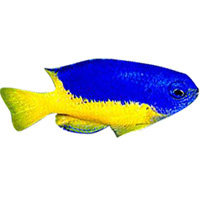
Call For The Best Price In Town!
Yellow Belly Blue Damsel, Pomacentrus auriventris is commonly found in the Indo-Pacific and Indo-Australian regions
and is characterized by the bright blue body with yellow toward the lower posterior. Being among the most peaceful of the
Damsel family, Pomacentrus genus members are omnivores that thrive with a variety of prepared and frozen foods. Damsels
are hardy and are reef safe. They will swim actively at all levels of the aquarium and are a great fish for aquarists of all
experience levels.
Snowflake Eel
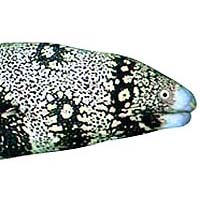
Call For The Best Price In Town!
Snowflake Eel, Echidna nebulosa, is a hardy, excellent addition to the marine aquarium. It is brown and black
with cream colored "snowflakes" marking its body. At a maximum length in the wild of three feet, it does not grow as large
as some other eels, adding to its popularity for the home aquarium. Largely a nocturnal feeder, the Snowflake Eel will often
be visible during the day, even if only when peering out from under or between any decorative rock provided. The Snowflake
Eel can be found in many parts of the Pacific Ocean, including the Red Sea, Japan, Hawaiian Islands, Southern California (USA),
and Central America. Eels are hearty eaters who also produce a great deal of waste. Because of this, a well-established aquarium
and excellent water filtration is highly recommended. This species may even learn to eat from the owner's hands (but be careful
of the strong jaws.) The Snowflake Eel is a carnivore who prefers meaty foods including silversides, krill, clam, and carnivore
preparations. It may be kept with other fish, as long as the fish do not fit into the Eel's mouth. The Snowflake Eel will
likely devour any crustaceans with which it is kept. As with all Eels, an aquarium with a tight-fitting cover must be provided
to prevent escape.
Approximate Arrival Size for Snowflake Eel: Small - 5" to 8", Medium - 9" to 12", Large -
13"+
Yellow Tang
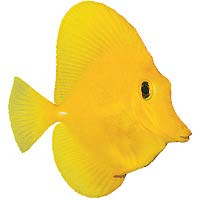
Call For The Best Price In Town!
Yellow Tangs, Zebrasoma flavescens, are found dispersed throughout the waters of the Hawaiian and Indo Pacific
regions. Members of the genus Zebrasoma are also called sailfin tangs, making reference to their extended dorsal and anal
fins, which resemble the sails of a ship. These tangs are agile swimmers and entertain the aquarium viewers with their amusing
antics. Small schools can be maintained if the aquarium is large with lots of rocks/corals. Tangs are herbivores and their
diets should therefore contain a variety of marine vegetable matter, such as seaweed.
Domino Damsel
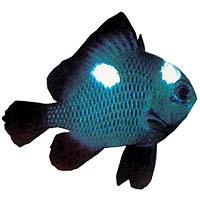
Call For The Best Price In Town!
|
 |
|
|
|
